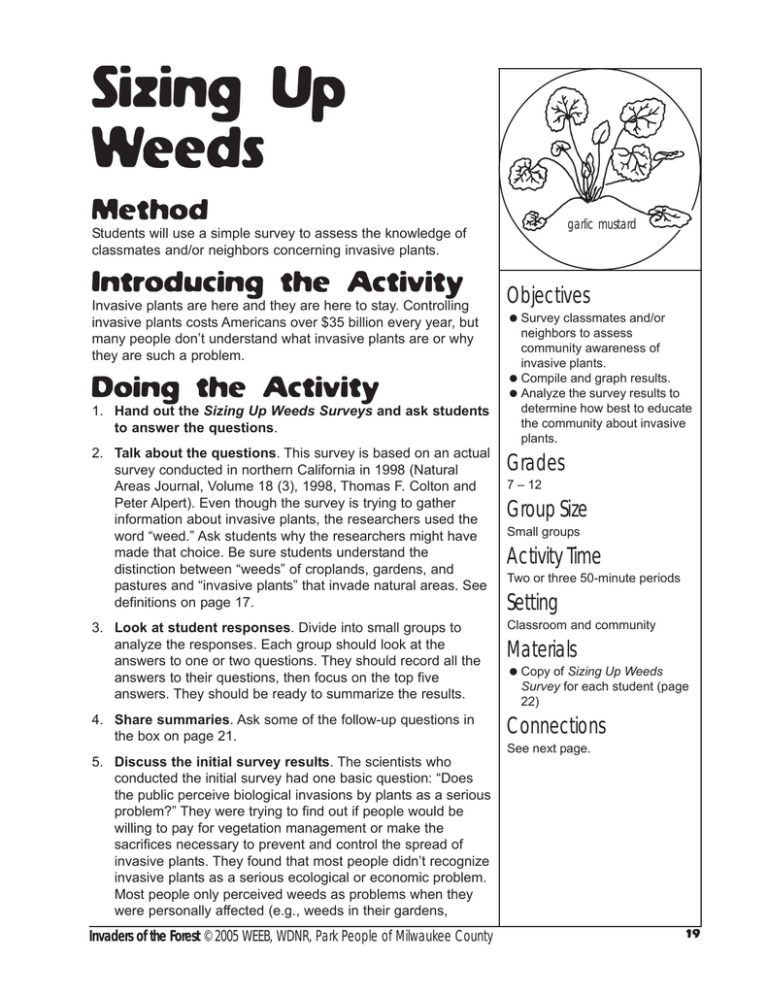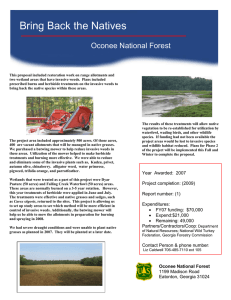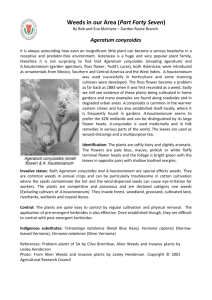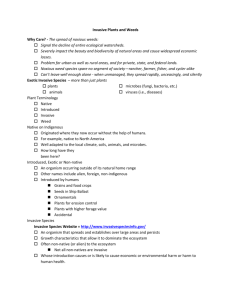Sizing Up Weeds Method
advertisement

Sizing Up Weeds Method garlic mustard Students will use a simple survey to assess the knowledge of classmates and/or neighbors concerning invasive plants. Introducing the Activity Invasive plants are here and they are here to stay. Controlling invasive plants costs Americans over $35 billion every year, but many people don’t understand what invasive plants are or why they are such a problem. Doing the Activity 1. Hand out the Sizing Up Weeds Surveys and ask students to answer the questions. Objectives Survey classmates and/or neighbors to assess community awareness of invasive plants. Compile and graph results. Analyze the survey results to determine how best to educate the community about invasive plants. 2. Talk about the questions. This survey is based on an actual survey conducted in northern California in 1998 (Natural Areas Journal, Volume 18 (3), 1998, Thomas F. Colton and Peter Alpert). Even though the survey is trying to gather information about invasive plants, the researchers used the word “weed.” Ask students why the researchers might have made that choice. Be sure students understand the distinction between “weeds” of croplands, gardens, and pastures and “invasive plants” that invade natural areas. See definitions on page 17. Grades 3. Look at student responses. Divide into small groups to analyze the responses. Each group should look at the answers to one or two questions. They should record all the answers to their questions, then focus on the top five answers. They should be ready to summarize the results. Classroom and community 4. Share summaries. Ask some of the follow-up questions in the box on page 21. Connections 7 – 12 Group Size Small groups Activity Time Two or three 50-minute periods Setting Materials Copy of Sizing Up Weeds Survey for each student (page 22) See next page. 5. Discuss the initial survey results. The scientists who conducted the initial survey had one basic question: “Does the public perceive biological invasions by plants as a serious problem?” They were trying to find out if people would be willing to pay for vegetation management or make the sacrifices necessary to prevent and control the spread of invasive plants. They found that most people didn’t recognize invasive plants as a serious ecological or economic problem. Most people only perceived weeds as problems when they were personally affected (e.g., weeds in their gardens, Invaders of the Forest © 2005 WEEB, WDNR, Park People of Milwaukee County 19 Academic Standards Grades 7 – 8 English Language Arts: C.8.1, F.8.1 Environmental Education: C.8.3, C.8.4, D.8.7 Math: E.8.1 Science: A.8.1 Grades 9 – 12 English Language Arts: F.12.1 Environmental Education: D.12.6 Math: E.12.1 Science: A.12.2 allergy-causing weeds, or weeds that had “stickers”). Most people didn’t recognize local weeds as non-native species or think that they were a problem. Nor did they recognize the negative impacts that weeds have on natural areas. The survey was conducted in 1998. Ask students if they think people understand invasive plants any better today. Discuss how the students’ responses were similar to or different from the original survey responses discussed in this paragraph. 6. Prepare to conduct a local survey. Identify the target audience. Select questions for the survey. The class may choose to use the Sizing Up Weeds Survey or develop their own survey. They may choose to survey classmates, parents, neighbors, or a cross-section of the community. If students plan to conduct the survey in a public place, be sure to obtain permission. If students are surveying a wide variety of people, they may want to add questions about the age and level of education of their audience. When compiling results, students can then identify if these are factors in awareness of the problem. 7. Conduct the survey. 8. Compile data. Compile survey responses in simple data tables. 9. Graph responses. Divide into groups. Assign each group a question from the survey to graph. Graph the top five responses for each question. 10. Discuss results. Ask groups to present the findings from their questions. Here are some possible discussion questions: Is there a basic understanding of “weeds” in the community? For example, did the people surveyed acknowledge that weeds are present in natural areas, as well as gardens, croplands, pastures, and lawns? Did the people surveyed understand that weeds are spread by people, as well as by wind, water, and animals? Did the people surveyed understand that weeds (especially invasive plants) are a problem? Do they think weeds need to be controlled? If it were your job to educate the school/community about invasive plants, how would you begin? Assessing the Learning Based on the results of the survey, ask students to write a short paragraph describing how they would begin to educate the people in their community about invasive plants. 20 Invaders of the Forest © 2005 WEEB, WDNR, Park People of Milwaukee County Extending the Learning Discuss the problems caused by invasive plants. Share information from “Why Should We Be Concerned About Invasive Plants?” and “Ethical Implications” from Invasive Plants of the Upper Midwest, pages 5 – 7. Thinking about responses to the weed survey 1. Describe a typical weed. There are several possible responses. Weeds are plants that grow fast, spread quickly, and sprout where you don’t want them. They are persistent, difficult to kill, and ugly. They are often bad-tasting or covered with spines or bristles, making them unpalatable to herbivores. Look for references to non-native plants (e.g., come from other parts of the world). 2. List three weeds that are familiar to you. Take the top five answers and find out if the plants are native or non-native. Why did you identify these plants as weeds? Are these weeds found in croplands, pastures, gardens, roadsides, and/or natural areas? Do any simply have “weed” in their name (e.g., milkweed)? 3. Name the kinds of places where weeds grow. Common responses might include gardens, yards, lawns, fields, and croplands. Did any of the responses identify natural areas as places where weeds can grow? 4. How do weeds spread? Typical responses might include wind or animals. Did any of the responses show people taking responsibility for the spread of weeds? 9. List good qualities of weeds. Typical answers might include controlling erosion, looking pretty or attractive, and providing food and cover for wildlife. Remember, these are the reasons people introduce new plants in the first place! 10. Are these plants found naturally in Wisconsin or did they come from other countries? box elder – native to Wisconsin, but often aggressive Norway maple – non-native – Did the name give this plant’s origin away? common buckthorn – non-native garlic mustard – non-native burdock – non-native 11. What comes to your mind when you hear the word “biodiversity”? The initial surveyors were surprised to find that only college graduates were familiar with the term. Has that changed in the years since the initial surveys? 14. Are you concerned about invasive plants? How many responses showed that “invasive plant” was an unfamiliar term? Did the responses indicate an understanding that “invasive plants” invade natural areas? Invaders of the Forest © 2005 WEEB, WDNR, Park People of Milwaukee County 21 Student page Sizing Up Weeds Survey 1. Describe a typical weed. 2. List three weeds that are familiar to you. 3. Name the kinds of places where weeds grow. 4. How do weeds spread? 5. Have weeds ever caused you problems? Yes or no? If yes, briefly describe the problems. 6. Do weeds cause problems for society or the environment? Yes or no? If yes, briefly describe the problems. 7. Do you think weeds pose a threat to endangered plants and animals? Yes or no? If yes, what is the threat? 8. Do you think there should be more efforts to control weeds? 9. List good qualities of weeds. 10. Are these plants found naturally in Wisconsin or did they come from other countries? box elder Norway maple common buckthorn garlic mustard burdock 11. What comes to your mind when you hear the word “biodiversity”? 12. What do you think the term “biological invasion” means? 13. What is a native plant? 14. Are you concerned about invasive plants? 22 Invaders of the Forest © 2005 WEEB, WDNR, Park People of Milwaukee County






